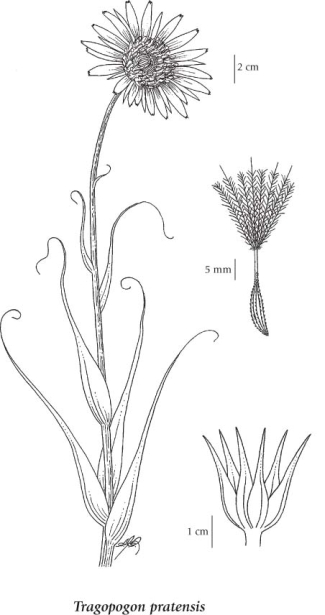meadow salsify
Asteraceae (Aster family)
Introduction to Vascular Plants
Species Information
General:
Biennial herb from a taproot; stems erect, solitary, simple or more commonly branching from the base, lightly woolly-hairy when young, becoming glabrous except at leaf bases, exuding milky juice when broken, 15-80 cm tall.
Leaves:
Basal leaves lacking; stem leaves entire, grasslike, becoming broader just above the base then tapering uniformly to the apex, parallel-veined with clasping bases, 5-30 cm long, 0.5-2 cm wide.
Flowers:
Heads with strap-shaped flowers, solitary, on straight, hollow stalks terminating the stems or few branches; involucres 1.2-2.4 cm tall; involucral bracts lanceolate, swollen at the base, equal, 5-11 or more commonly about 8, equalling or shorter than the ray flowers; ray flowers bright yellow; disk flowers lacking.
Fruits:
Achenes elongate, 5- to 10-ribbed, 1.2-2.4 cm long, abruptly tapering to the slender beak; pappus of whitish, slender tipped, feathery bristles, the feather branches interwebbed.
Illustration

If more than one illustration is available for a species (e.g., separate illustrations were provided for two subspecies) then links to the separate images will be provided below. Note that individual subspecies or varietal illustrations are not always available.
Illustration Source: The Illustrated Flora of British Columbia
Ecology
The table below shows the species-specific information calculated from
original data (BEC database) provided by the BC Ministry of Forests and Range.
(Updated August, 2013)
| Site Information |
Value / Class |
||
|
Avg |
Min |
Max |
|
| Elevation
(metres) |
796 | 311 | 1737 |
| Slope
Gradient (%) |
16 | 0 | 100 |
|
Aspect (degrees) |
186 | 3 | 360 |
| Soil
Moisture Regime (SMR) [0 - very xeric; 4 - mesic; 8 - hydric] |
3 | 1 | 7 |
| Modal
Nutrient Regime
Class |
C | ||
| #
of field plots species was recorded in: |
350 | ||
| Modal
BEC Zone Class |
BG | ||
|
All BEC Zones (# of stations/zone) species was recorded in |
BG(182), ICH(1), IDF(137), PP(14) | ||
|
Source:
Klinkenberg 2013
|
|||
Habitat and Range
Dry roadsides and waste places in the lowland, steppe and montane zones; common in SC BC, rare in coastal BC; introduced from Europe.Status Information
Taxonomic Keys
1. Stalks of the heads cylindric, not enlarged above; outer ray flowers yellow, equal to or exceeding the involucral bracts.........................T. pratensis
1. Stalks of the heads enlarged above outer ray flowers yellow or purple, shorter than the involucral bracts. 2. Ray flowers purple; involucral bracts usually 8-9; leaves dilated and clasping at the base.........................T. porrifolius 2. Ray flowers yellow; involucral bracts usually 13; leaves generally tapering evenly from the base to the tips..............................T. dubius Source: Illustrated Flora of British Columbia |